A Report on Flavonoids & AMD: Investigating the Effect on Prevalence
VerifiedAdded on 2023/06/07
|10
|2153
|82
Report
AI Summary
This report investigates the relationship between flavonoids and age-related macular degeneration (AMD) using a cohort study design. The study identifies the incidence of AMD as the independent variable and dietary intake of flavonoids as the dependent variable. It addresses potential biases like response and inclusive biases, and defines statistical terms such as incidence and prevalence in the context of AMD. The analysis controls for factors like age and sex, with age identified as a confounding factor. The report interprets statistical values, including odds ratios and confidence intervals, to assess the impact of flavanols on AMD, particularly through the consumption of oranges. It concludes by suggesting descriptive research for future studies and emphasizes the importance of maintaining participant anonymity. The study aligns with the Brad-ford Hill test theory, supporting the consistency and coherency of the findings.
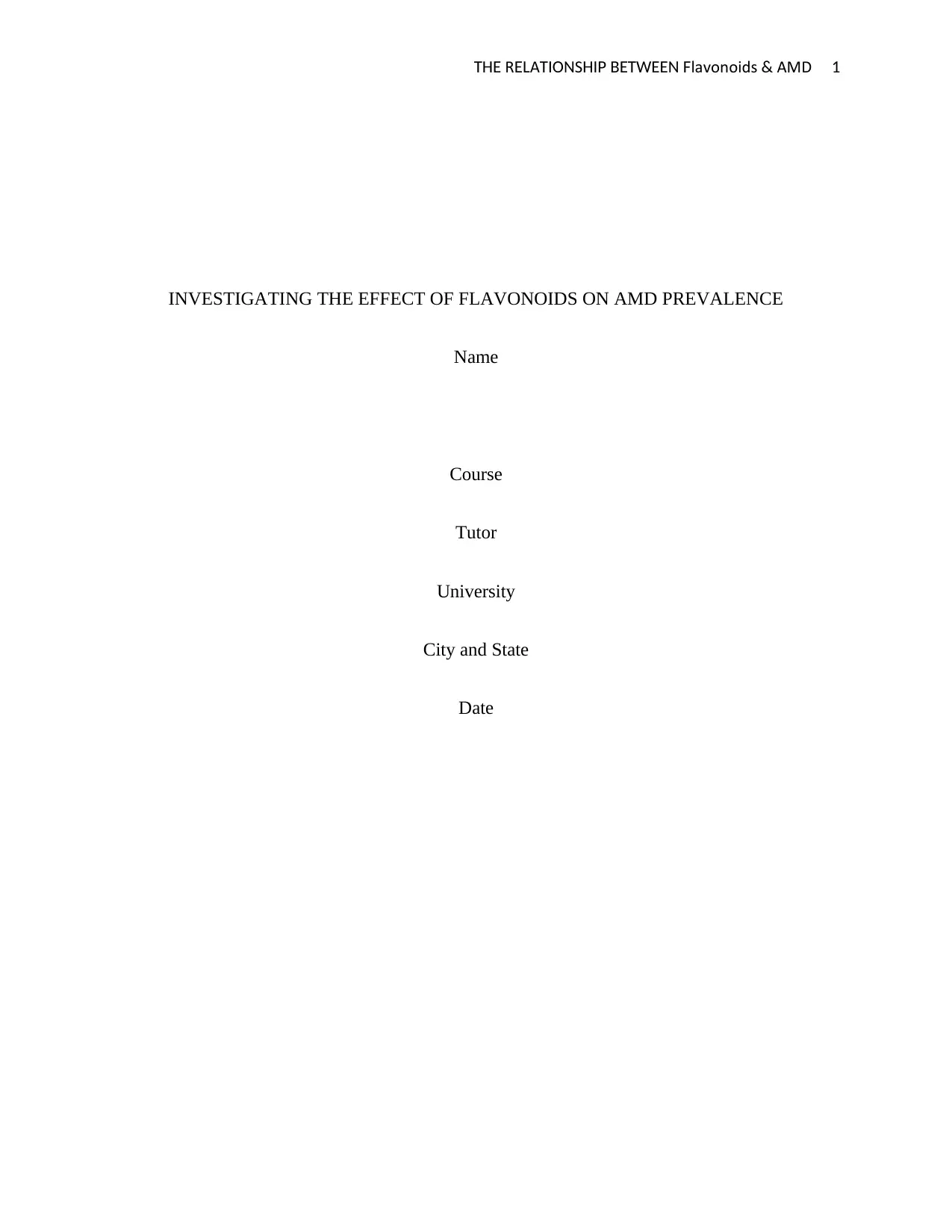
R A S lavonoids AMDTHE EL TION HIP BETWEEN F & 1
INVESTIGATING THE EFFECT OF FLAVONOIDS ON AMD PREVALENCE
Name
Course
Tutor
University
City and State
Date
INVESTIGATING THE EFFECT OF FLAVONOIDS ON AMD PREVALENCE
Name
Course
Tutor
University
City and State
Date
Paraphrase This Document
Need a fresh take? Get an instant paraphrase of this document with our AI Paraphraser
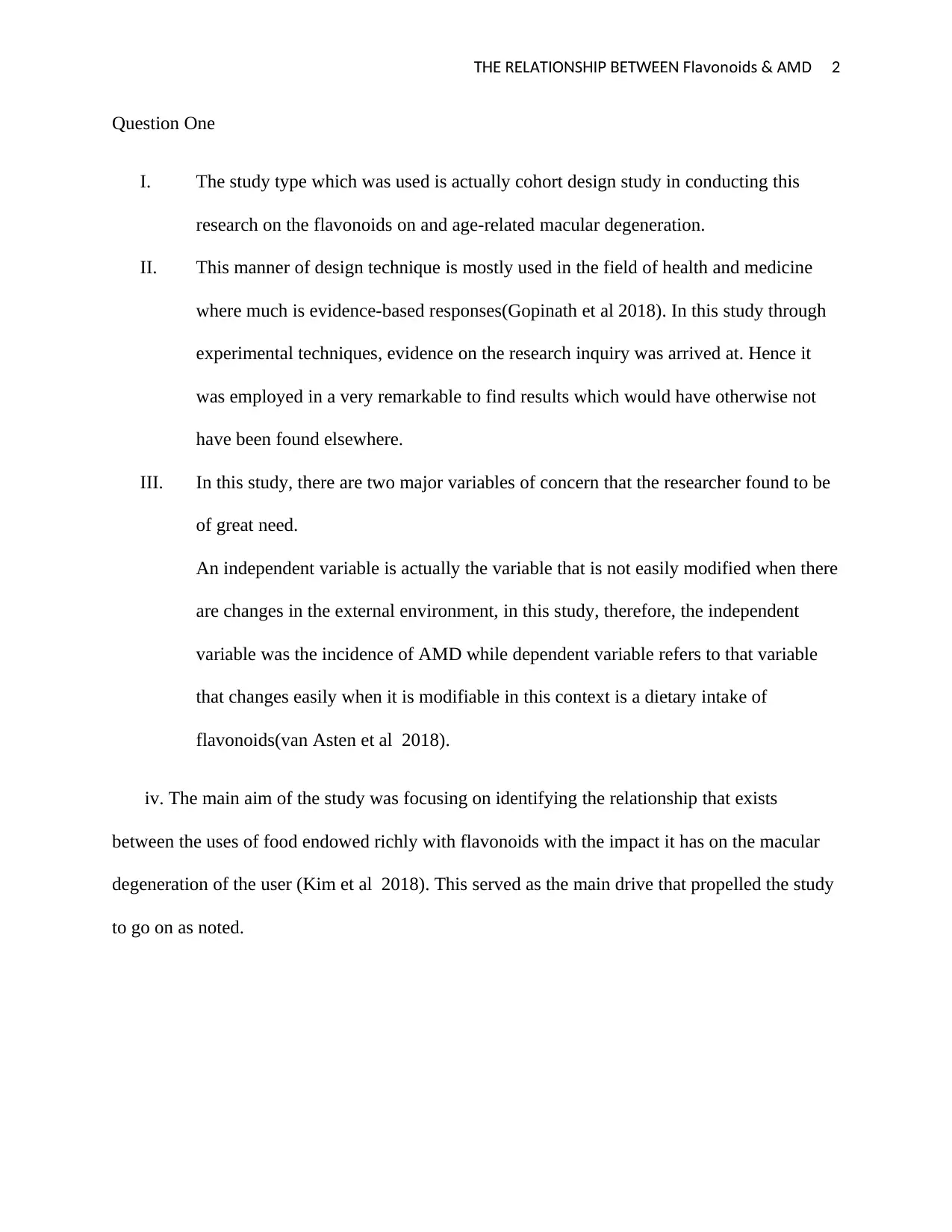
R A S lavonoids AMDTHE EL TION HIP BETWEEN F & 2
Question One
I. The study type which was used is actually cohort design study in conducting this
research on the flavonoids on and age-related macular degeneration.
II. This manner of design technique is mostly used in the field of health and medicine
where much is evidence-based responses(Gopinath et al 2018). In this study through
experimental techniques, evidence on the research inquiry was arrived at. Hence it
was employed in a very remarkable to find results which would have otherwise not
have been found elsewhere.
III. In this study, there are two major variables of concern that the researcher found to be
of great need.
An independent variable is actually the variable that is not easily modified when there
are changes in the external environment, in this study, therefore, the independent
variable was the incidence of AMD while dependent variable refers to that variable
that changes easily when it is modifiable in this context is a dietary intake of
flavonoids(van Asten et al 2018).
iv. The main aim of the study was focusing on identifying the relationship that exists
between the uses of food endowed richly with flavonoids with the impact it has on the macular
degeneration of the user (Kim et al 2018). This served as the main drive that propelled the study
to go on as noted.
Question One
I. The study type which was used is actually cohort design study in conducting this
research on the flavonoids on and age-related macular degeneration.
II. This manner of design technique is mostly used in the field of health and medicine
where much is evidence-based responses(Gopinath et al 2018). In this study through
experimental techniques, evidence on the research inquiry was arrived at. Hence it
was employed in a very remarkable to find results which would have otherwise not
have been found elsewhere.
III. In this study, there are two major variables of concern that the researcher found to be
of great need.
An independent variable is actually the variable that is not easily modified when there
are changes in the external environment, in this study, therefore, the independent
variable was the incidence of AMD while dependent variable refers to that variable
that changes easily when it is modifiable in this context is a dietary intake of
flavonoids(van Asten et al 2018).
iv. The main aim of the study was focusing on identifying the relationship that exists
between the uses of food endowed richly with flavonoids with the impact it has on the macular
degeneration of the user (Kim et al 2018). This served as the main drive that propelled the study
to go on as noted.
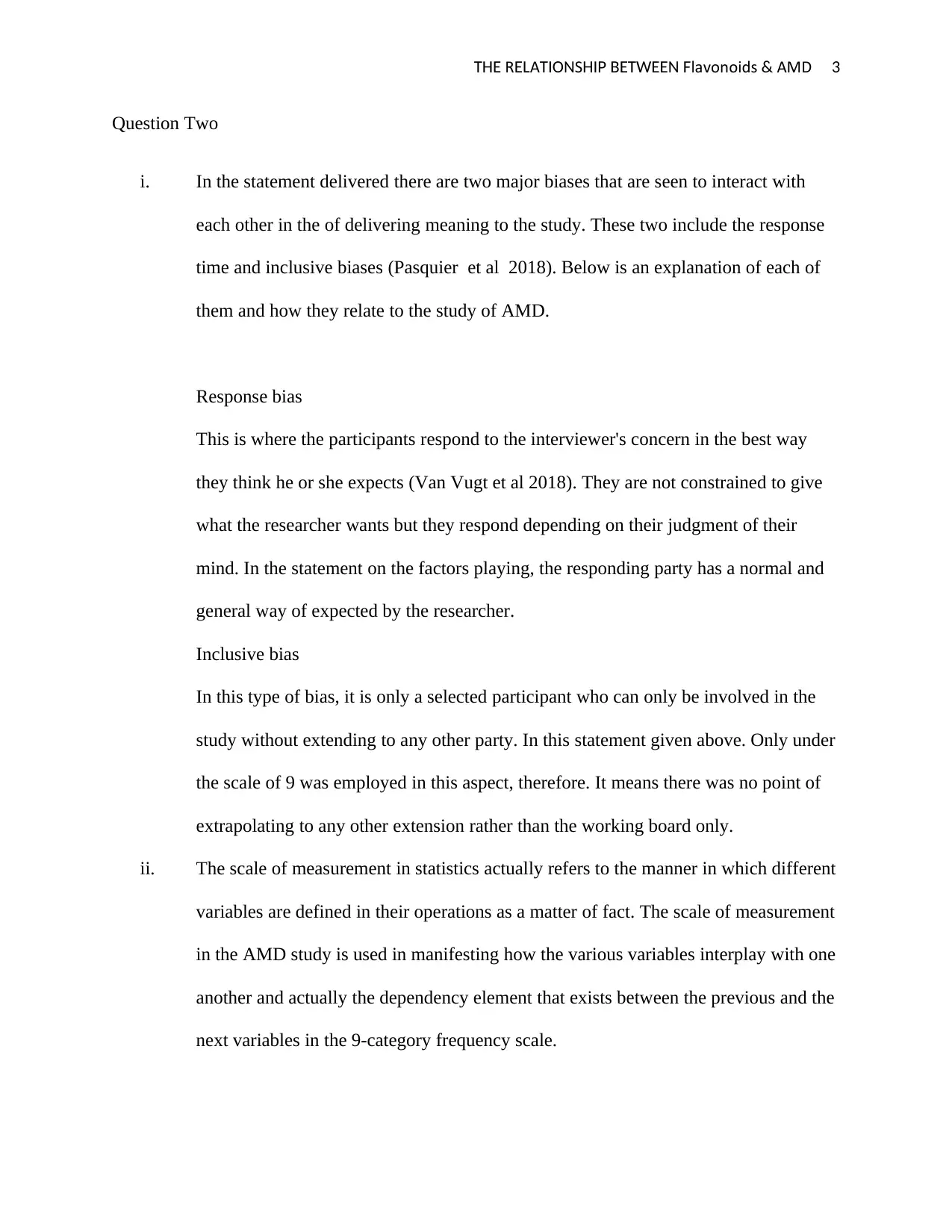
R A S lavonoids AMDTHE EL TION HIP BETWEEN F & 3
Question Two
i. In the statement delivered there are two major biases that are seen to interact with
each other in the of delivering meaning to the study. These two include the response
time and inclusive biases (Pasquier et al 2018). Below is an explanation of each of
them and how they relate to the study of AMD.
Response bias
This is where the participants respond to the interviewer's concern in the best way
they think he or she expects (Van Vugt et al 2018). They are not constrained to give
what the researcher wants but they respond depending on their judgment of their
mind. In the statement on the factors playing, the responding party has a normal and
general way of expected by the researcher.
Inclusive bias
In this type of bias, it is only a selected participant who can only be involved in the
study without extending to any other party. In this statement given above. Only under
the scale of 9 was employed in this aspect, therefore. It means there was no point of
extrapolating to any other extension rather than the working board only.
ii. The scale of measurement in statistics actually refers to the manner in which different
variables are defined in their operations as a matter of fact. The scale of measurement
in the AMD study is used in manifesting how the various variables interplay with one
another and actually the dependency element that exists between the previous and the
next variables in the 9-category frequency scale.
Question Two
i. In the statement delivered there are two major biases that are seen to interact with
each other in the of delivering meaning to the study. These two include the response
time and inclusive biases (Pasquier et al 2018). Below is an explanation of each of
them and how they relate to the study of AMD.
Response bias
This is where the participants respond to the interviewer's concern in the best way
they think he or she expects (Van Vugt et al 2018). They are not constrained to give
what the researcher wants but they respond depending on their judgment of their
mind. In the statement on the factors playing, the responding party has a normal and
general way of expected by the researcher.
Inclusive bias
In this type of bias, it is only a selected participant who can only be involved in the
study without extending to any other party. In this statement given above. Only under
the scale of 9 was employed in this aspect, therefore. It means there was no point of
extrapolating to any other extension rather than the working board only.
ii. The scale of measurement in statistics actually refers to the manner in which different
variables are defined in their operations as a matter of fact. The scale of measurement
in the AMD study is used in manifesting how the various variables interplay with one
another and actually the dependency element that exists between the previous and the
next variables in the 9-category frequency scale.
⊘ This is a preview!⊘
Do you want full access?
Subscribe today to unlock all pages.

Trusted by 1+ million students worldwide
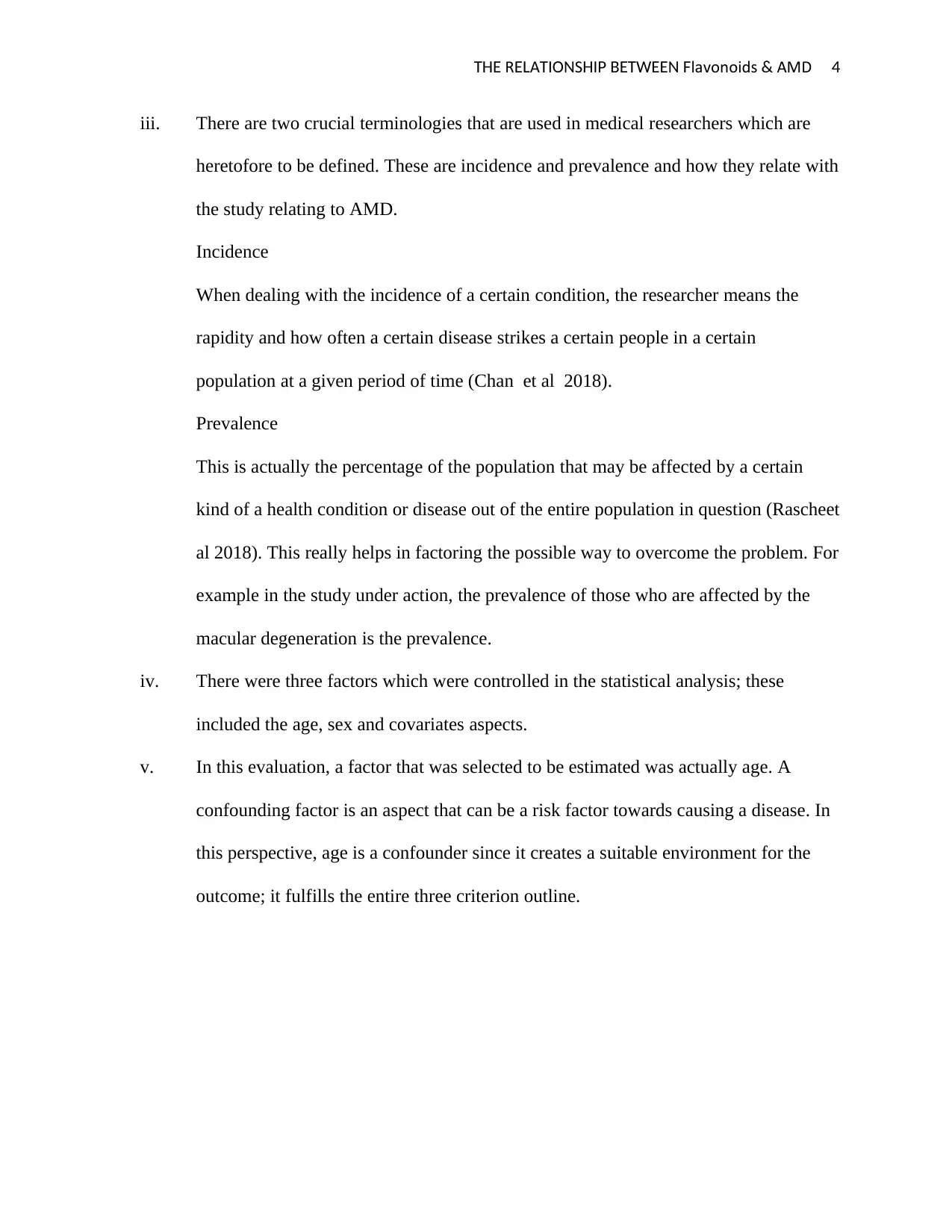
R A S lavonoids AMDTHE EL TION HIP BETWEEN F & 4
iii. There are two crucial terminologies that are used in medical researchers which are
heretofore to be defined. These are incidence and prevalence and how they relate with
the study relating to AMD.
Incidence
When dealing with the incidence of a certain condition, the researcher means the
rapidity and how often a certain disease strikes a certain people in a certain
population at a given period of time (Chan et al 2018).
Prevalence
This is actually the percentage of the population that may be affected by a certain
kind of a health condition or disease out of the entire population in question (Rascheet
al 2018). This really helps in factoring the possible way to overcome the problem. For
example in the study under action, the prevalence of those who are affected by the
macular degeneration is the prevalence.
iv. There were three factors which were controlled in the statistical analysis; these
included the age, sex and covariates aspects.
v. In this evaluation, a factor that was selected to be estimated was actually age. A
confounding factor is an aspect that can be a risk factor towards causing a disease. In
this perspective, age is a confounder since it creates a suitable environment for the
outcome; it fulfills the entire three criterion outline.
iii. There are two crucial terminologies that are used in medical researchers which are
heretofore to be defined. These are incidence and prevalence and how they relate with
the study relating to AMD.
Incidence
When dealing with the incidence of a certain condition, the researcher means the
rapidity and how often a certain disease strikes a certain people in a certain
population at a given period of time (Chan et al 2018).
Prevalence
This is actually the percentage of the population that may be affected by a certain
kind of a health condition or disease out of the entire population in question (Rascheet
al 2018). This really helps in factoring the possible way to overcome the problem. For
example in the study under action, the prevalence of those who are affected by the
macular degeneration is the prevalence.
iv. There were three factors which were controlled in the statistical analysis; these
included the age, sex and covariates aspects.
v. In this evaluation, a factor that was selected to be estimated was actually age. A
confounding factor is an aspect that can be a risk factor towards causing a disease. In
this perspective, age is a confounder since it creates a suitable environment for the
outcome; it fulfills the entire three criterion outline.
Paraphrase This Document
Need a fresh take? Get an instant paraphrase of this document with our AI Paraphraser
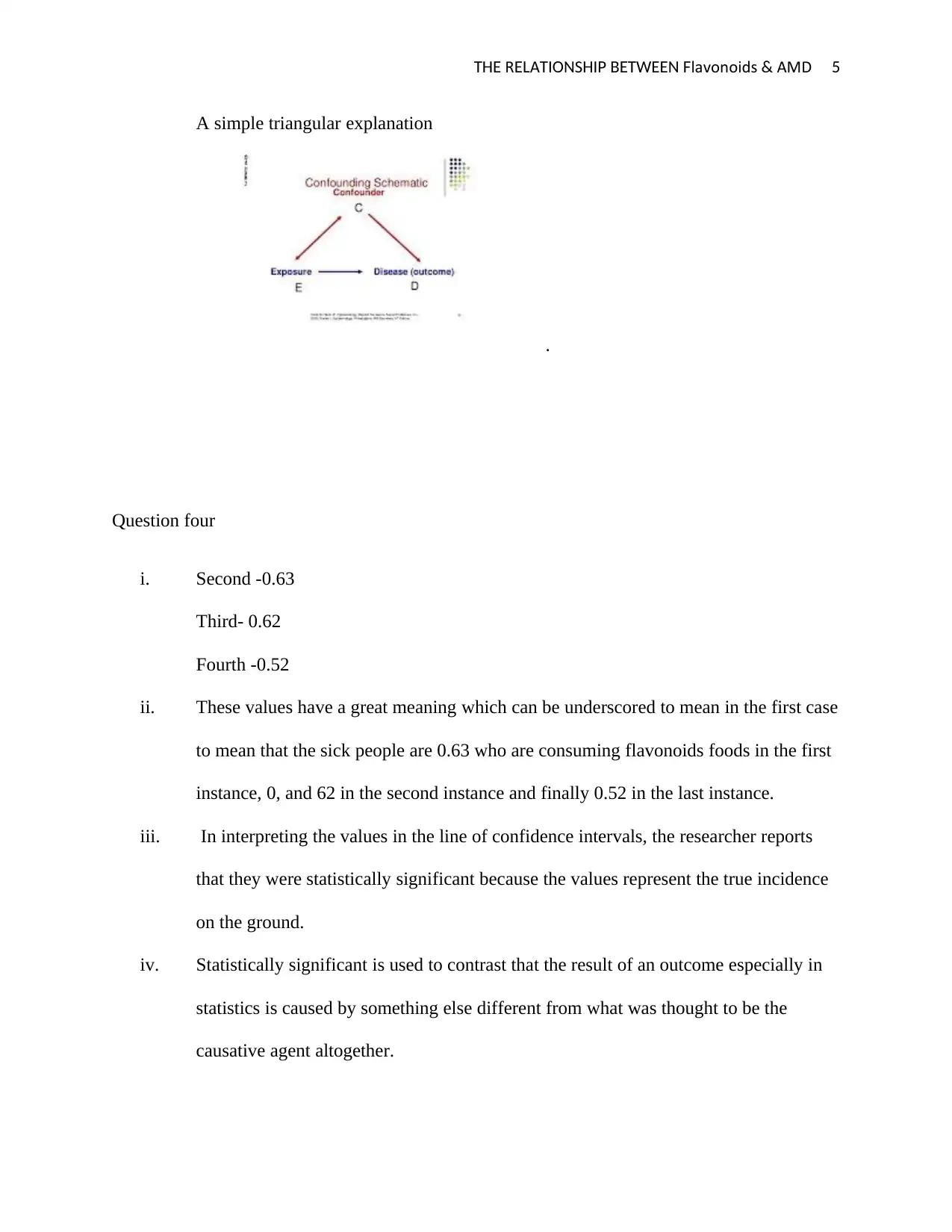
R A S lavonoids AMDTHE EL TION HIP BETWEEN F & 5
A simple triangular explanation
.
Question four
i. Second -0.63
Third- 0.62
Fourth -0.52
ii. These values have a great meaning which can be underscored to mean in the first case
to mean that the sick people are 0.63 who are consuming flavonoids foods in the first
instance, 0, and 62 in the second instance and finally 0.52 in the last instance.
iii. In interpreting the values in the line of confidence intervals, the researcher reports
that they were statistically significant because the values represent the true incidence
on the ground.
iv. Statistically significant is used to contrast that the result of an outcome especially in
statistics is caused by something else different from what was thought to be the
causative agent altogether.
A simple triangular explanation
.
Question four
i. Second -0.63
Third- 0.62
Fourth -0.52
ii. These values have a great meaning which can be underscored to mean in the first case
to mean that the sick people are 0.63 who are consuming flavonoids foods in the first
instance, 0, and 62 in the second instance and finally 0.52 in the last instance.
iii. In interpreting the values in the line of confidence intervals, the researcher reports
that they were statistically significant because the values represent the true incidence
on the ground.
iv. Statistically significant is used to contrast that the result of an outcome especially in
statistics is caused by something else different from what was thought to be the
causative agent altogether.
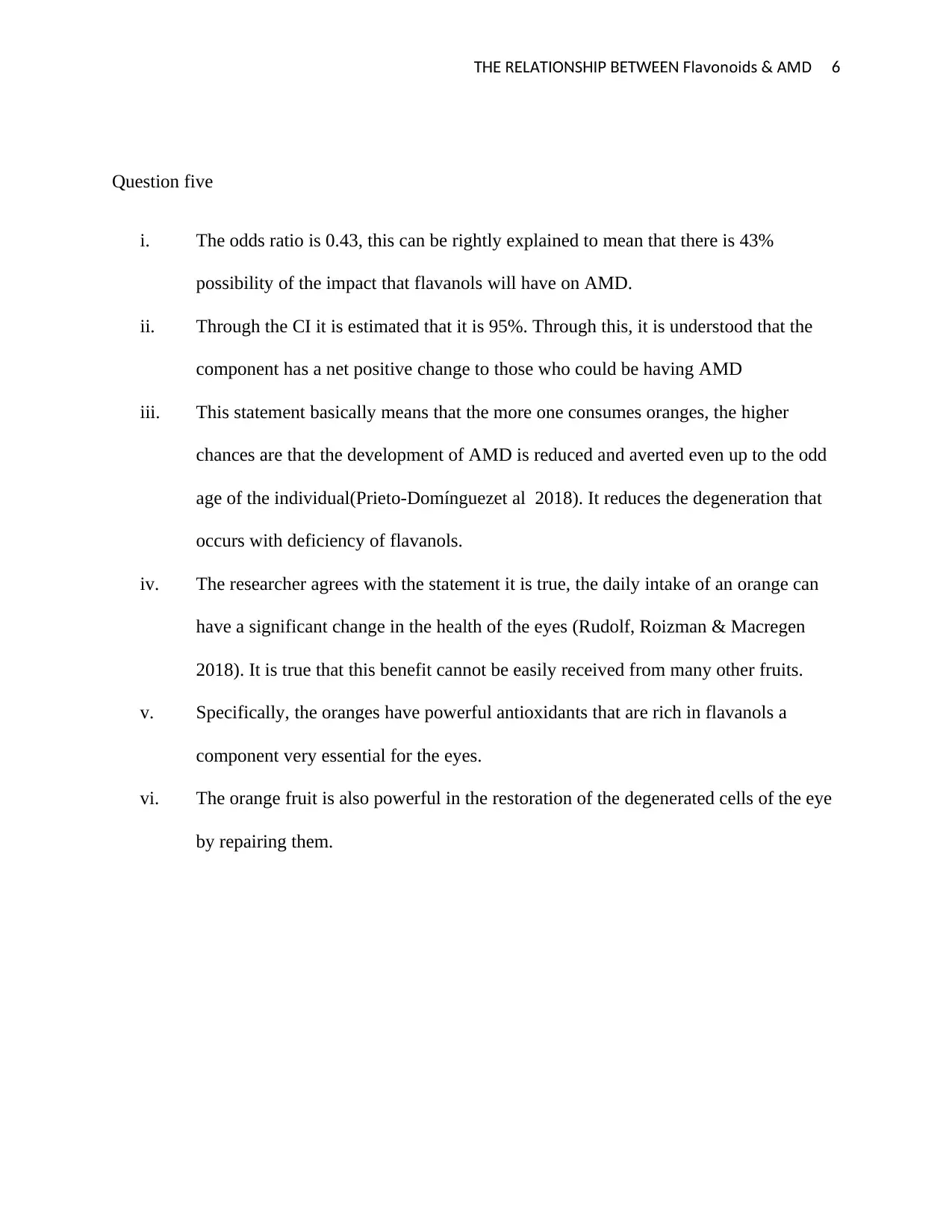
R A S lavonoids AMDTHE EL TION HIP BETWEEN F & 6
Question five
i. The odds ratio is 0.43, this can be rightly explained to mean that there is 43%
possibility of the impact that flavanols will have on AMD.
ii. Through the CI it is estimated that it is 95%. Through this, it is understood that the
component has a net positive change to those who could be having AMD
iii. This statement basically means that the more one consumes oranges, the higher
chances are that the development of AMD is reduced and averted even up to the odd
age of the individual(Prieto-Domínguezet al 2018). It reduces the degeneration that
occurs with deficiency of flavanols.
iv. The researcher agrees with the statement it is true, the daily intake of an orange can
have a significant change in the health of the eyes (Rudolf, Roizman & Macregen
2018). It is true that this benefit cannot be easily received from many other fruits.
v. Specifically, the oranges have powerful antioxidants that are rich in flavanols a
component very essential for the eyes.
vi. The orange fruit is also powerful in the restoration of the degenerated cells of the eye
by repairing them.
Question five
i. The odds ratio is 0.43, this can be rightly explained to mean that there is 43%
possibility of the impact that flavanols will have on AMD.
ii. Through the CI it is estimated that it is 95%. Through this, it is understood that the
component has a net positive change to those who could be having AMD
iii. This statement basically means that the more one consumes oranges, the higher
chances are that the development of AMD is reduced and averted even up to the odd
age of the individual(Prieto-Domínguezet al 2018). It reduces the degeneration that
occurs with deficiency of flavanols.
iv. The researcher agrees with the statement it is true, the daily intake of an orange can
have a significant change in the health of the eyes (Rudolf, Roizman & Macregen
2018). It is true that this benefit cannot be easily received from many other fruits.
v. Specifically, the oranges have powerful antioxidants that are rich in flavanols a
component very essential for the eyes.
vi. The orange fruit is also powerful in the restoration of the degenerated cells of the eye
by repairing them.
⊘ This is a preview!⊘
Do you want full access?
Subscribe today to unlock all pages.

Trusted by 1+ million students worldwide
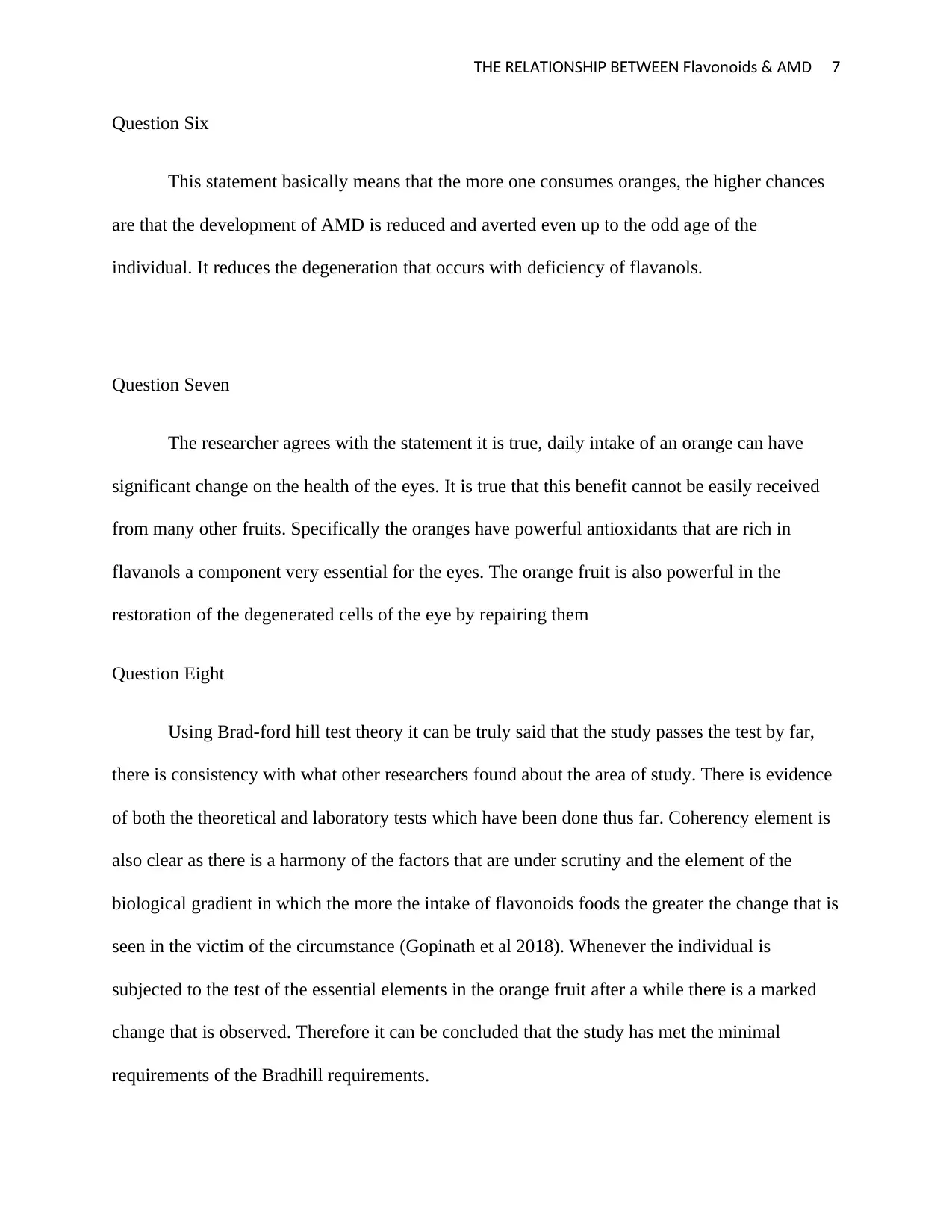
R A S lavonoids AMDTHE EL TION HIP BETWEEN F & 7
Question Six
This statement basically means that the more one consumes oranges, the higher chances
are that the development of AMD is reduced and averted even up to the odd age of the
individual. It reduces the degeneration that occurs with deficiency of flavanols.
Question Seven
The researcher agrees with the statement it is true, daily intake of an orange can have
significant change on the health of the eyes. It is true that this benefit cannot be easily received
from many other fruits. Specifically the oranges have powerful antioxidants that are rich in
flavanols a component very essential for the eyes. The orange fruit is also powerful in the
restoration of the degenerated cells of the eye by repairing them
Question Eight
Using Brad-ford hill test theory it can be truly said that the study passes the test by far,
there is consistency with what other researchers found about the area of study. There is evidence
of both the theoretical and laboratory tests which have been done thus far. Coherency element is
also clear as there is a harmony of the factors that are under scrutiny and the element of the
biological gradient in which the more the intake of flavonoids foods the greater the change that is
seen in the victim of the circumstance (Gopinath et al 2018). Whenever the individual is
subjected to the test of the essential elements in the orange fruit after a while there is a marked
change that is observed. Therefore it can be concluded that the study has met the minimal
requirements of the Bradhill requirements.
Question Six
This statement basically means that the more one consumes oranges, the higher chances
are that the development of AMD is reduced and averted even up to the odd age of the
individual. It reduces the degeneration that occurs with deficiency of flavanols.
Question Seven
The researcher agrees with the statement it is true, daily intake of an orange can have
significant change on the health of the eyes. It is true that this benefit cannot be easily received
from many other fruits. Specifically the oranges have powerful antioxidants that are rich in
flavanols a component very essential for the eyes. The orange fruit is also powerful in the
restoration of the degenerated cells of the eye by repairing them
Question Eight
Using Brad-ford hill test theory it can be truly said that the study passes the test by far,
there is consistency with what other researchers found about the area of study. There is evidence
of both the theoretical and laboratory tests which have been done thus far. Coherency element is
also clear as there is a harmony of the factors that are under scrutiny and the element of the
biological gradient in which the more the intake of flavonoids foods the greater the change that is
seen in the victim of the circumstance (Gopinath et al 2018). Whenever the individual is
subjected to the test of the essential elements in the orange fruit after a while there is a marked
change that is observed. Therefore it can be concluded that the study has met the minimal
requirements of the Bradhill requirements.
Paraphrase This Document
Need a fresh take? Get an instant paraphrase of this document with our AI Paraphraser
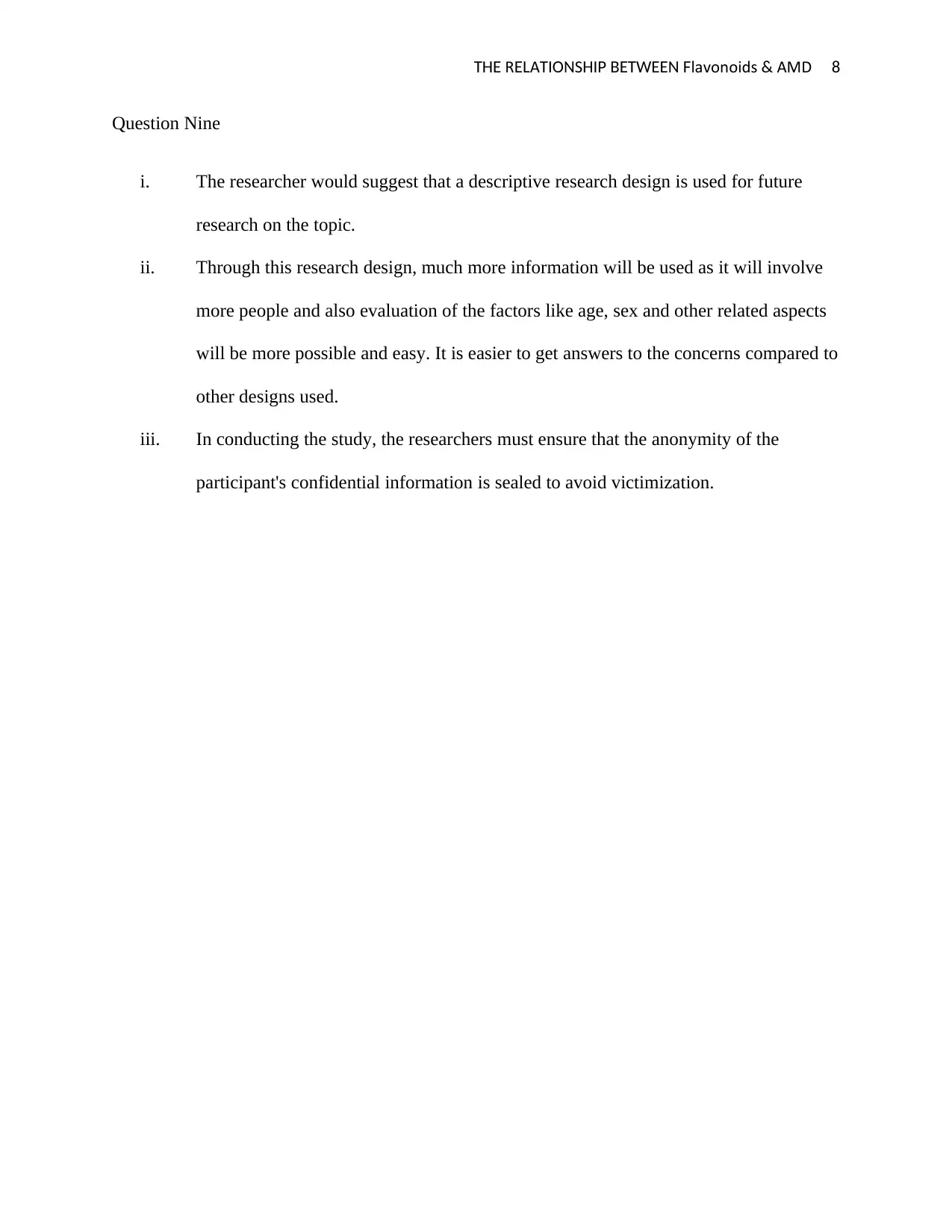
R A S lavonoids AMDTHE EL TION HIP BETWEEN F & 8
Question Nine
i. The researcher would suggest that a descriptive research design is used for future
research on the topic.
ii. Through this research design, much more information will be used as it will involve
more people and also evaluation of the factors like age, sex and other related aspects
will be more possible and easy. It is easier to get answers to the concerns compared to
other designs used.
iii. In conducting the study, the researchers must ensure that the anonymity of the
participant's confidential information is sealed to avoid victimization.
Question Nine
i. The researcher would suggest that a descriptive research design is used for future
research on the topic.
ii. Through this research design, much more information will be used as it will involve
more people and also evaluation of the factors like age, sex and other related aspects
will be more possible and easy. It is easier to get answers to the concerns compared to
other designs used.
iii. In conducting the study, the researchers must ensure that the anonymity of the
participant's confidential information is sealed to avoid victimization.
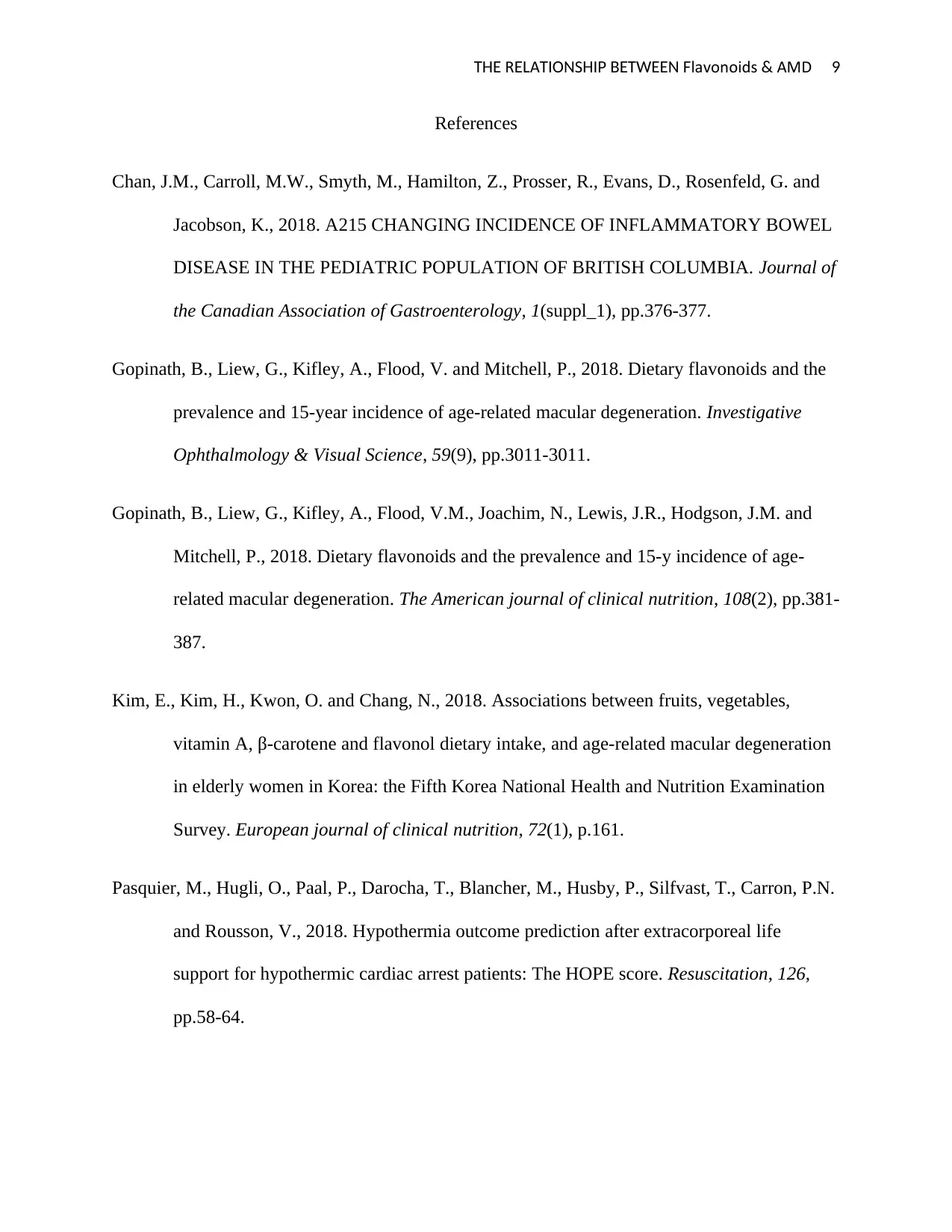
R A S lavonoids AMDTHE EL TION HIP BETWEEN F & 9
References
Chan, J.M., Carroll, M.W., Smyth, M., Hamilton, Z., Prosser, R., Evans, D., Rosenfeld, G. and
Jacobson, K., 2018. A215 CHANGING INCIDENCE OF INFLAMMATORY BOWEL
DISEASE IN THE PEDIATRIC POPULATION OF BRITISH COLUMBIA. Journal of
the Canadian Association of Gastroenterology, 1(suppl_1), pp.376-377.
Gopinath, B., Liew, G., Kifley, A., Flood, V. and Mitchell, P., 2018. Dietary flavonoids and the
prevalence and 15-year incidence of age-related macular degeneration. Investigative
Ophthalmology & Visual Science, 59(9), pp.3011-3011.
Gopinath, B., Liew, G., Kifley, A., Flood, V.M., Joachim, N., Lewis, J.R., Hodgson, J.M. and
Mitchell, P., 2018. Dietary flavonoids and the prevalence and 15-y incidence of age-
related macular degeneration. The American journal of clinical nutrition, 108(2), pp.381-
387.
Kim, E., Kim, H., Kwon, O. and Chang, N., 2018. Associations between fruits, vegetables,
vitamin A, β-carotene and flavonol dietary intake, and age-related macular degeneration
in elderly women in Korea: the Fifth Korea National Health and Nutrition Examination
Survey. European journal of clinical nutrition, 72(1), p.161.
Pasquier, M., Hugli, O., Paal, P., Darocha, T., Blancher, M., Husby, P., Silfvast, T., Carron, P.N.
and Rousson, V., 2018. Hypothermia outcome prediction after extracorporeal life
support for hypothermic cardiac arrest patients: The HOPE score. Resuscitation, 126,
pp.58-64.
References
Chan, J.M., Carroll, M.W., Smyth, M., Hamilton, Z., Prosser, R., Evans, D., Rosenfeld, G. and
Jacobson, K., 2018. A215 CHANGING INCIDENCE OF INFLAMMATORY BOWEL
DISEASE IN THE PEDIATRIC POPULATION OF BRITISH COLUMBIA. Journal of
the Canadian Association of Gastroenterology, 1(suppl_1), pp.376-377.
Gopinath, B., Liew, G., Kifley, A., Flood, V. and Mitchell, P., 2018. Dietary flavonoids and the
prevalence and 15-year incidence of age-related macular degeneration. Investigative
Ophthalmology & Visual Science, 59(9), pp.3011-3011.
Gopinath, B., Liew, G., Kifley, A., Flood, V.M., Joachim, N., Lewis, J.R., Hodgson, J.M. and
Mitchell, P., 2018. Dietary flavonoids and the prevalence and 15-y incidence of age-
related macular degeneration. The American journal of clinical nutrition, 108(2), pp.381-
387.
Kim, E., Kim, H., Kwon, O. and Chang, N., 2018. Associations between fruits, vegetables,
vitamin A, β-carotene and flavonol dietary intake, and age-related macular degeneration
in elderly women in Korea: the Fifth Korea National Health and Nutrition Examination
Survey. European journal of clinical nutrition, 72(1), p.161.
Pasquier, M., Hugli, O., Paal, P., Darocha, T., Blancher, M., Husby, P., Silfvast, T., Carron, P.N.
and Rousson, V., 2018. Hypothermia outcome prediction after extracorporeal life
support for hypothermic cardiac arrest patients: The HOPE score. Resuscitation, 126,
pp.58-64.
⊘ This is a preview!⊘
Do you want full access?
Subscribe today to unlock all pages.

Trusted by 1+ million students worldwide
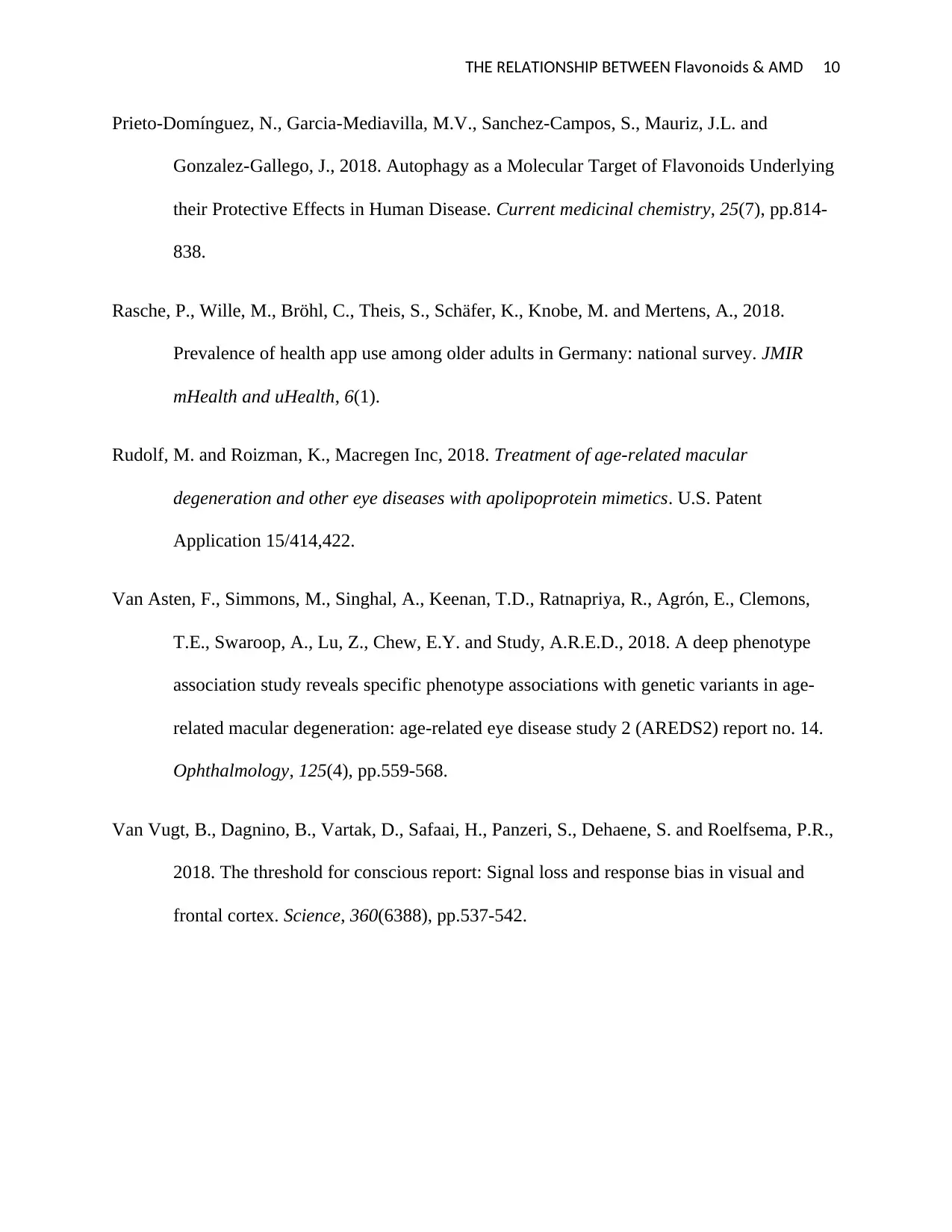
R A S lavonoids AMDTHE EL TION HIP BETWEEN F & 10
Prieto-Domínguez, N., Garcia-Mediavilla, M.V., Sanchez-Campos, S., Mauriz, J.L. and
Gonzalez-Gallego, J., 2018. Autophagy as a Molecular Target of Flavonoids Underlying
their Protective Effects in Human Disease. Current medicinal chemistry, 25(7), pp.814-
838.
Rasche, P., Wille, M., Bröhl, C., Theis, S., Schäfer, K., Knobe, M. and Mertens, A., 2018.
Prevalence of health app use among older adults in Germany: national survey. JMIR
mHealth and uHealth, 6(1).
Rudolf, M. and Roizman, K., Macregen Inc, 2018. Treatment of age-related macular
degeneration and other eye diseases with apolipoprotein mimetics. U.S. Patent
Application 15/414,422.
Van Asten, F., Simmons, M., Singhal, A., Keenan, T.D., Ratnapriya, R., Agrón, E., Clemons,
T.E., Swaroop, A., Lu, Z., Chew, E.Y. and Study, A.R.E.D., 2018. A deep phenotype
association study reveals specific phenotype associations with genetic variants in age-
related macular degeneration: age-related eye disease study 2 (AREDS2) report no. 14.
Ophthalmology, 125(4), pp.559-568.
Van Vugt, B., Dagnino, B., Vartak, D., Safaai, H., Panzeri, S., Dehaene, S. and Roelfsema, P.R.,
2018. The threshold for conscious report: Signal loss and response bias in visual and
frontal cortex. Science, 360(6388), pp.537-542.
Prieto-Domínguez, N., Garcia-Mediavilla, M.V., Sanchez-Campos, S., Mauriz, J.L. and
Gonzalez-Gallego, J., 2018. Autophagy as a Molecular Target of Flavonoids Underlying
their Protective Effects in Human Disease. Current medicinal chemistry, 25(7), pp.814-
838.
Rasche, P., Wille, M., Bröhl, C., Theis, S., Schäfer, K., Knobe, M. and Mertens, A., 2018.
Prevalence of health app use among older adults in Germany: national survey. JMIR
mHealth and uHealth, 6(1).
Rudolf, M. and Roizman, K., Macregen Inc, 2018. Treatment of age-related macular
degeneration and other eye diseases with apolipoprotein mimetics. U.S. Patent
Application 15/414,422.
Van Asten, F., Simmons, M., Singhal, A., Keenan, T.D., Ratnapriya, R., Agrón, E., Clemons,
T.E., Swaroop, A., Lu, Z., Chew, E.Y. and Study, A.R.E.D., 2018. A deep phenotype
association study reveals specific phenotype associations with genetic variants in age-
related macular degeneration: age-related eye disease study 2 (AREDS2) report no. 14.
Ophthalmology, 125(4), pp.559-568.
Van Vugt, B., Dagnino, B., Vartak, D., Safaai, H., Panzeri, S., Dehaene, S. and Roelfsema, P.R.,
2018. The threshold for conscious report: Signal loss and response bias in visual and
frontal cortex. Science, 360(6388), pp.537-542.
1 out of 10
Related Documents
Your All-in-One AI-Powered Toolkit for Academic Success.
+13062052269
info@desklib.com
Available 24*7 on WhatsApp / Email
![[object Object]](/_next/static/media/star-bottom.7253800d.svg)
Unlock your academic potential
Copyright © 2020–2025 A2Z Services. All Rights Reserved. Developed and managed by ZUCOL.





